George Washington is quoted as saying, “We need chaplains” while addressing the Continental Congress before the service was formally established on July 29th, 1775. That means U.S. Army chaplains have been around since before the Declaration of Independence was signed.
During the Revolutionary War, they acted as spiritual leaders to help inspire and motivate soldiers. Little has changed since then. The U.S. Army Chaplain Corps (DACH) still serves a critical role in the daily functions of the Army by providing religious and moral support.
Every year since its birthday, the anniversary of the DACH is celebrated. This July 29th, you can use the opportunity to acknowledge the exemplary work of the DACH in your own way.
Here, we’ll discuss the DACH”s mission and how you can potentially become a chaplain.
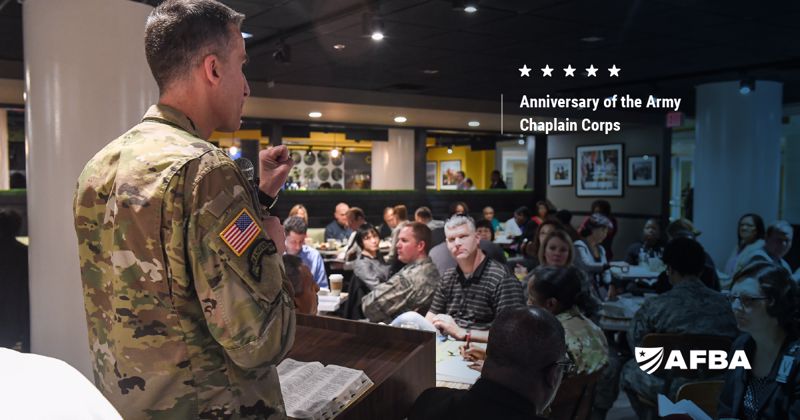 “The appearance of the U.S. Department of Defense (DoD) visual information does not imply or constitute DoD endorsement.”
“The appearance of the U.S. Department of Defense (DoD) visual information does not imply or constitute DoD endorsement.”What does the DACH do?
The primary purpose behind the DACH is to offer support to the U.S. Army. This is usually religious support for a wide range of faiths, but they also help those who do not subscribe to any particular religion. This can include counseling, church services or other moral support. They also:
- Serve in correctional or medical facilities or combat hospitals.
- Offer family or marriage counseling.
- Can act as instructors in officer service schools.
Some chaplains choose to further their training and education to prepare them for higher-level work. This could mean taking on staffing responsibilities, handling personnel-related tasks, or being involved in financial and logistical duties.
The DACH never stops working. In peacetime or war, whether soldiers are deployed or at home, chaplains are always there to offer their services. They understand that servicemembers have a near-infinite variety of backgrounds, and they aim to help all who could benefit.
Army chaplains aren’t restricted in what type of unit they serve. Intelligence, infantry, community ministries, hospitals — you will find chaplains in all these places.
Considered non-combat personnel, chaplains are supported by religious affairs specialists. In addition to organizing worship services and religious programs, these specialist troops have administrative duties and must act as an armed guard to ensure chaplains’ safety in combat situations.
How do you become an Army chaplain?
Chaplains serve a vital purpose in their units, meaning they must undergo extensive education and training programs to prepare themselves for such great responsibilities. They’re treated as Army officers and receive all the privileges other officers have.
Unlike some other Army positions, Army chaplains must have formal higher education: at least a bachelor’s degree. In some cases, graduating college seniors can enlist.
An endorsement from the applicant’s faith group is necessary, as is being enrolled full-time in an accredited graduate program that can qualify them for ordination.
Another challenge is the Chaplain Candidate Program (CCP). Ministry students may begin this training while they’re still in school.
Chaplains are exempt from Basic Combat Training (BCT) but still undergo physical tests to build strength and endurance. Chaplains must pass the Chaplain Basic Officer Leader Course (CHBOLC): In addition to requiring an adequate level of fitness, this course trains chaplains academically and spiritually.
Celebrate the anniversary of the Chaplain Corps this July 29
The DACH has had nearly 250 anniversary celebrations during its lifetime, and they’ve remained a core part of many Army units. On July 29th, show your appreciation for the DACH and its role in providing religious support to every soldier.
A shared holiday between the U.S. and South Korea, Korean War Veterans Armistice Day has been celebrated every year for the past 70 years on July 27 since 1953. Its purpose is to honor veterans of the Korean War, which gave South Korea (then known as the Republic of Korea) independence from North Korea, which was called the Democratic People’s Republic of Korea at that time.
The Korean War is often referred to as “The Forgotten War” because of how little media attention it got. However, advocates for Korean War veterans fought to bring recognition to the heroic sacrifices of the many who died during the conflict. Soon after, Korean War Veterans Armistice Day was nationally recognized. It became a tradition for the President of the United States to make an address each year on the armistice’s anniversary.
The Deadly Chosin Reservoir Campaign
The Chosin Reservoir Campaign was an especially deadly period in which over 5,000 American troops died in the winter of 1950, either from the elements or in combat. One key battle in which the Chinese attacked the U.S. Marine-led forces became pivotal to winning the war. These efforts were not in vain and ultimately led to the U.S. and South Korea succeeding in rebuking North Korea and China.
Acting as a backup force for the North Koreans, this campaign was a core aspect of the Chinese Second Offensive. Its purpose was to force the United Nations to retreat from North Korea by destroying the 1st U.S. Marine Division, which had entered North Korea from the east before marching inland. They were in a weakened state and in a vulnerable position when the Chinese chose their moment to attack. About 120,000 Chinese soldiers attacked the remaining 15,000 U.S. soldiers and Marines, who fought alongside 15,000 UN soldiers.
The remaining U.S. and UN forces battled through the Chinese ranks to reach transport ships at the coast. This required moving through a series of mountain passes, a bridged chasm and a narrow road — a 78-mile hike through the most treacherous terrain in Korea.
Despite the odds being strongly against them, the historic General Douglas MacArthur led an effort that succeeded in heroically fighting through the Chinese army and evacuating 98,000 refugees while preventing the annihilation of the UN forces. The battle became legendary in Marine Corps lore as one of their greatest moments.
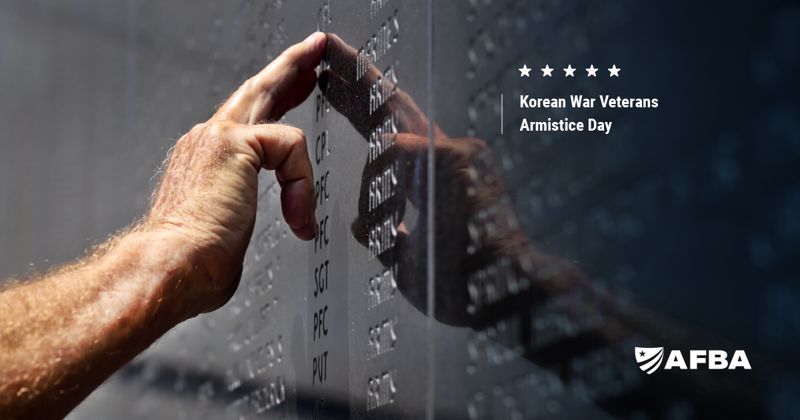 “The appearance of the U.S. Department of Defense (DoD) visual information does not imply or constitute DoD endorsement.”
“The appearance of the U.S. Department of Defense (DoD) visual information does not imply or constitute DoD endorsement.”The end of the Korean War
The U.S. considered the Korean War a fight against communism itself. They feared that if North Korea succeeded in overtaking South Korea, the Soviets and their allies would be emboldened to invade more countries.
There was fear among some, especially the Americans, that a prolonged conflict could bring Russia into the war — potentially bringing about World War III. They were thus strongly motivated to reach an armistice as soon as they could. By the time the Korean War ended in July 1953, an estimated 23,600 U.S. servicemembers had died. North Korea’s invasion was unsuccessful, and there were few territory shifts.
Pay respects to Korean War veterans on July 27
Thanks to the efforts of advocates, July 27 is a national holiday in which we honor veterans of the Korean War. Pay your respects to these distinguished individuals when the anniversary of the armistice comes. These are servicemembers who most certainly shouldn’t be forgotten in “the forgotten war.”
When summer hits, the kids are off, your spouse’s PTO is saved up and the promise of a fun adventure is on the horizon. A trip to Washington DC could serve to be a rewarding experience for the whole family. Not only do you get to feel the heartbeat of America, but you can also dive into its deep history.
Before booking your trip, here’s what you need to know and some spots to put on your itinerary.
Planning your trip
DC has a lot to offer the common traveler. From the White House and Capitol to the presidential and military memorials. With so many attractions and potentially not a lot of time to see them, it’s important to narrow your choices and focus on a specific aspect of the city. Let’s get down to how to plan your trip.
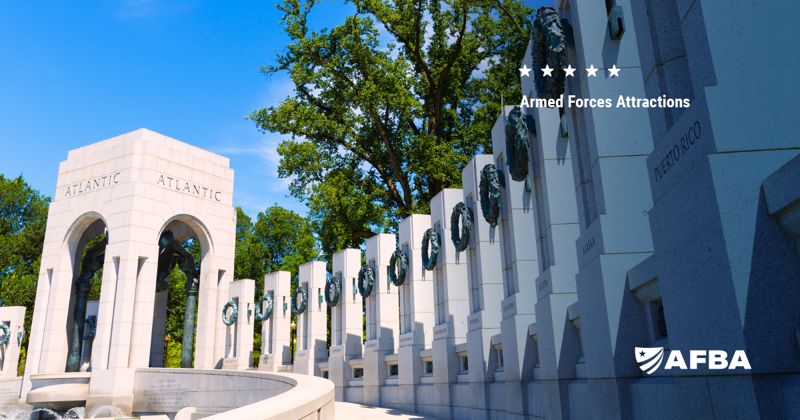 “The appearance of the U.S. Department of Defense (DoD) visual information does not imply or constitute DoD endorsement.”
“The appearance of the U.S. Department of Defense (DoD) visual information does not imply or constitute DoD endorsement.”AFBA travel benefits
If you’re an AFBA member, you have certain travel benefits you should take advantage of before booking anything.
- Car rental discounts: While DC is notoriously easy to walk through and shared rides are abundant, you may consider booking a car rental. This can be helpful if you want to stay somewhere outside the city and visit surrounding sites, want to make DC more accessible on your own time or have specific travel needs like wheelchair access.
- Armed Forces vacation club: From hotels to exclusive discounts, any member of AFBA can benefit from starting their itinerary with this one-stop-shop website.
- Wholesale hotel rates: Receive wholesale rates at over 600,000 hotels around the country — that’s 60% of any hotel on the list!
All of these advantages can put your trip on the right foot.
What to bring and not bring
Traveling comes with it a host of decisions, but here’s what to bring and leave behind on your trip.
Summer in DC is known for its humidity and average temperatures falling between the high 80s and low 90s. These two weather conditions combined make for summer storms as well. So, pack your raincoat, a good pair of walking shoes and your favorite breezy summer clothes to make this trip the best one yet.
DC is also a fairly large city, and it could get confusing if you’re not familiar with the area. Map out where each site and attraction is beforehand so you’re not wasting your time zig-zagging across town. If you book a tour, be sure to mark where the guide will meet you.
The top museums and locations to visit
Along with the main attractions like the National Mall and the Lincoln Memorial, here are the best places to see if you’re a military history enthusiast:
- The Korean War Veterans Memorial.
- National World War II Memorial.
- Smithsonian National Museum of American History.
- National Museum of the United States Army.
- Vietnam Veterans Memorial.
- National Museum of the United States Navy.
There is a lot to do and see when you visit Washington DC. Once you have your itinerary planned out, enjoy the music, food, art and culture of the area.
There are few jobs as selfless or necessary as the military caregiver. These individuals — who can be friends, distant relatives, family members, or anyone else who wants to help — assist disabled members of the military with activities they can no longer perform on their own. This can include showering, eating or dressing. A military caregiver might also be called a veteran caregiver if the individual receiving care is a veteran but not an active servicemember.
Despite the name, not all military caregivers identify as caregivers. A military caregiver isn’t necessarily a job title (though for some, it can be), but rather a catch-all term for someone who helps a servicemember or veteran with daily activities.
While they’re necessary to the service member’s life, many military caregivers don’t get the resources they need to manage. Being a military caregiver is often extremely stressful, and many give up basic necessities in their lives to serve their member(s) of the military. That’s why, in addition to talking about how valuable military caregivers are, we’ll also be discussing the resources available to them — and how you can help.
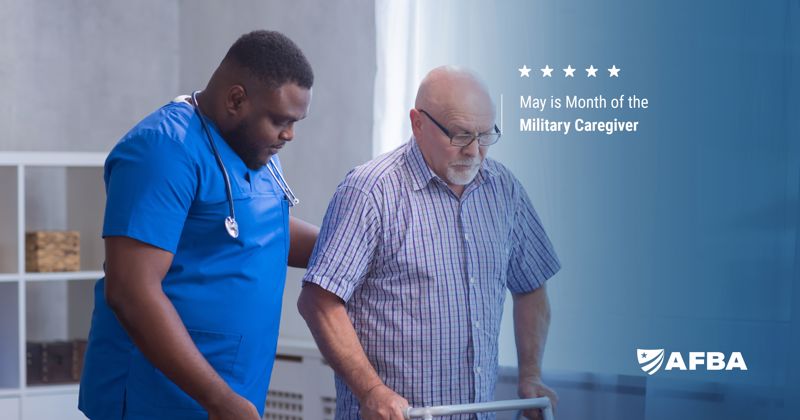 “The appearance of the U.S. Department of Defense (DoD) visual information does not imply or constitute DoD endorsement.”
“The appearance of the U.S. Department of Defense (DoD) visual information does not imply or constitute DoD endorsement.”How else do military caregivers help?
A military caregiver may not assist with physical activities at all, but instead (or even in addition to this) serve a servicemember by:
- Offering emotional support.
- Taking care of legal or financial responsibilities.
- Managing their schedule and transportation to and from appointments.
Active duty members of the armed forces and veterans alike often don’t get the help they need to function in their daily lives. A military caregiver is someone who makes that possible.
The challenges military caregivers face (and the help they can get)
Serving indirectly as a military caregiver isn’t easy. It can be incredibly stressful and eventually lead to burnout, which in turn can lead to serious psychiatric symptoms such as anxiety and depression.
Luckily, there are some programs available that aim to assist those who sacrifice more than just their own time and energy to care for active service members and veterans (many give up their education, health and finances as well). One is the Department of Defense, which has been reaching out to military caregivers since 2013 to provide support. They offer resources such as networking opportunities with other caregivers to help each other cope emotionally, physically and financially. For many military caregivers, opportunities like these are invaluable for their own well-being.
Other nonprofit programs such as the Wounded Warrior Project exist to help wounded members of the military return to being active participants in their community, among many other services the organization offers. Military caregivers can also take advantage of the extra help.
What can you do to help?
If you want to become involved in helping military caregivers care for both their service member(s) and themselves, reach out to one and offer whatever assistance you can. They will surely appreciate it.
Alternatively, you can donate to a cause such as the Wounded Warrior Project that directly benefits military caregivers. You can also call up your nearest army station or veterans affairs office and ask if they know of any local opportunities to get involved.
Become a positive force for military caregivers so they can continue to serve
Military caregivers give their bodies and souls to caring for an active duty service member or veteran. Just as the military community constantly needs help, so are the people who are crucial in improving their quality of life.
This May, recognize and honor those who indirectly serve in this way.
If you’re a servicemember, veteran, dependent or any other eligible type of passenger, you may qualify for free accommodations on Space-A flights if a vacancy is available.
What is a Space-A flight?
Space-A stands for space-available flight and is also referred to as military hopping. If a Department of Defense (DoD) aircraft has vacancies when traveling between air bases, eligible persons may fill these seats at no charge, according to the John S. McCain National Defense Authorization Act. The purpose of Space-A is to give certain types of people the freedom to travel on flights that have vacancies.
Space-A flights can be on commercial airplanes, but they might also be on fuel tankers or cargo aircraft.
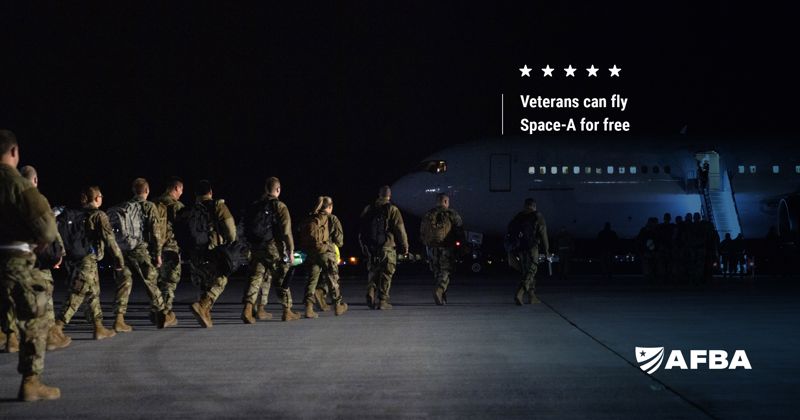 “The appearance of the U.S. Department of Defense (DoD) visual information does not imply or constitute DoD endorsement.”
“The appearance of the U.S. Department of Defense (DoD) visual information does not imply or constitute DoD endorsement.”The different categories of travelers
Depending on who you are and the reason for your travel, you’re placed in one of six categories. When Space-A considers who gets priority when someone requests to fill a vacancy, the lower categories get picked first. Here are the different categories and what they might include:
Category 1: Emergency leave travel
The emphasis here is on the word “emergency.” People who might qualify for this category include DoD civilian employees who are stationed overseas or full-time American Red Cross employees serving in a military capacity.
Category 2: Accompanied environmental and morale leave (EML)
This might include DoD Dependent School (DoDDS) teachers on vacation or sponsors traveling for EML purposes.
Category 3: Ordinary leave, house hunting TDY
Those on ordinary leave or military members who are house hunting (following PCS orders) generally qualify for this rank.
Category 4: Unaccompanied dependents on EML
Family members on EML are in this tier. This also encompasses DoDDS teachers and their family members.
Category 5: Permissive TDY, students, dependents, post-deployment/mobilization respite absence
If their sponsor is stationed overseas or in Alaska or Hawaii, students fall into this group.
Category 6: Retirees, dependents, reservists and disabled veterans
This category would apply to these types of flyers on vacation, for example.
How to sign up for Space-A flights
Signing up for a Space-A flight is very different from booking a seat on a commercial aircraft. You won’t be using traditional airports or booking accommodation at all; instead, you’ll communicate with an Air Mobility Command (AMC) Passenger Terminal to reserve a spot.
These are instructions to keep in mind, according to AMC. More information can be found on their website.
- Ensure your eligibility. There are six categories of travel that determine your eligibility for Space-A, with lower categories getting higher priority. This includes emergency leave, unfunded travel, and accompanied or unaccompanied environmental and morale leave (EML). Which category you fall into depends on the reason behind your travel and your duty status.
- Check which locations are available. Review your closest AMC Passenger Terminal through their social media page or website.
- Make sure your documents are in order. Look at which travel documents you need to prepare before your flight. This includes your passport (with visas, if applicable).
- Register at an AMC Passenger Terminal.
- Look at flight schedules. There is a 72-hour flight schedule on the American Forces Public Information Management System (AFPIMS) web page.
- Check-in at the terminal counter. Familiarize yourself with any newly updated flight information and declare that you are present. If everything is in order, the terminal will give you a Space-A call when they’re ready for you to board.
Roam the skies for free with Space-A flights
While not everyone is eligible to ride on a Space-A flight under all circumstances, as long as you meet the basic requirements, you can take advantage of this perk. For more information, contact your nearest AMC passenger terminal.
There is still a strong stigma attached to mental health. Mental Health Awareness Month is the perfect time to help shatter that perception and inspire those who need it to seek out help.
One group that experiences increased rates of psychiatric illness are first responders and armed forces servicemembers, especially those who were in combat. Too many suffer in silence, though they don’t have to, as there are many programs available specifically for veterans and first responders alike. Operation Resiliency is one such example that aims to help servicemembers deal with mental health issues by encouraging interaction between soldiers who share bonds forged through combat in the military.
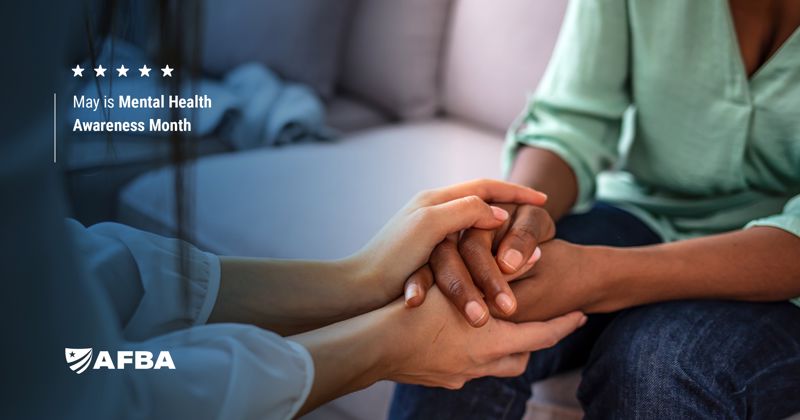 “The appearance of the U.S. Department of Defense (DoD) visual information does not imply or constitute DoD endorsement.”
“The appearance of the U.S. Department of Defense (DoD) visual information does not imply or constitute DoD endorsement.”Operation Resiliency
The underlying concept behind Operation Resiliency is that soldiers who form bonds in combat can help each other cope with trauma. Operation Resiliency hopes to assist both active duty and veteran service members better manage their mental health by bringing them together with no-cost retreats close to their homes. They also follow up with these individuals in an effort to keep connections strong among these soldiers.
Since the end of 2022, Operation Resiliency has served 468 service members. The project aims to hold six more retreats throughout 2023.
The origin of Operation Resiliency
The concept for Operation Resiliency came from Sarah Verardo, whose husband, Mike, was badly wounded in Afghanistan.
Verardo served in Bravo Company, 2nd Battalion, 508th Parachute Infantry Regiment of the 82nd Airborne Division. This unit fought in the especially deadly Arghandab region in Afghanistan, where nearly half of the soldiers in the team were awarded Purple Hearts. When several of these infantrymen committed suicide, Sarah called retired Army Command Sgt. Maj. Donald McAlister, first sergeant for Bravo Company in the Arghandab. They conceived of Operation Resiliency as part of their joint belief that they should do their part to prevent further tragedy.
McAlister led the first retreat for veterans in Bravo Company in North Carolina, where nearly 100 veterans of the company showed up. He believed he should lead them with full transparency of his own difficult reality to encourage others to do the same. “…Leading by example was being open and honest, and letting them know that mentally, physically, I’ll never be the man I was before…But at the end of the day, that’s OK…I told them, ‘You know, it’s OK for us all to not be OK, as long as we, as long as we acknowledge it. We can see the enemy, see what’s coming at us,” said McAllister, according to a report by the U.S. Department of Defense.
Psychiatric illnesses are not a sign of weakness
One in five adults suffers from mental illness, as claimed by the National Institute of Mental Health. This statistic is the same for first responders and those who serve in the armed forces. No one — no matter how tough the person may be — is immune, and no one can “power through” psychiatric disorder through sheer force of will any more than they can a broken leg.
If you’re experiencing a crisis or if you feel you may hurt yourself or others, you can dial 988, which connects you to the Suicide and Crisis Lifeline. Calling 911 is also an option.
Bravo Company is an example of the strongest among us recognizing their experiences and reaching out to their combat brothers for relief. Programs such as Operation Resiliency give these soldiers hope — which is what they require most in their time of need.
Women are the fastest-growing group in the veteran population, according to a report by the U.S. Department of Veterans Affairs. In 2000, the share of veterans who were women was 4%. By 2040, it’s projected to be 18%.
There are several factors contributing to the rise in women veterans, notably a shift in attitude toward women in the military. But women have found ways to serve even when they’re told they can’t. Here, we’ll talk about the developing trend of women joining the armed forces and touch on their accomplished history.
Increasing opportunities for women in the military
One of the biggest drivers of this increase is a more welcoming environment for women in the military. This was touched on in a previous blog post about Women’s History Month and Lieutenant Colonel Kathy La Sauce, who was one of the first women to serve in the Air Force in an active role. Before then, women had few opportunities in the armed forces, particularly in positions of power.
Times have changed, however. Today, women can serve in any position, including in leadership and combat roles.
That’s not to say women don’t have a long history of serving in some form or fashion. While it’s only been in recent decades that women have begun enlisting in larger numbers and reaching new heights, the origins of women assisting the U.S. armed forces go as far back as the Revolutionary War.
Women have served in the military since the Revolutionary War
 “The appearance of the U.S. Department of Defense (DoD) visual information does not imply or constitute DoD endorsement.”
“The appearance of the U.S. Department of Defense (DoD) visual information does not imply or constitute DoD endorsement.”For some exceptional people, feelings of patriotism overwhelm them so much they’re willing to overcome any obstacle — including being barred from officially serving in the armed forces. Such was the case with women who contributed during the Revolutionary War.
When colonial militias fought for Washington in the Continental Army, women — mothers, wives and daughters alike — insisted on coming to do their part. They did everything they could to help, including foraging for food, performing first aid and keeping the cannons functional.
Margaret Corbin was especially notable for the lengths she was willing to go. In addition to performing the aforementioned duties, Corbin disguised herself as a man so she could fight in a combat role alongside her husband, John. During the Battle of Fort Washington, she assisted John in loading the cannon. When he was killed by enemy fire, Margaret held her ground and continued to load and fire the cannon. When she was severely wounded by the British and permanently lost the use of her left arm, Washington’s forces granted her a military pension. She was the first woman to receive one.
The women serving today
The women who serve today are different from before. Many women veterans are part of an ethnic minority and/or unmarried, and they’re far more likely to serve as officers, according to Pew Research. They also serve in all branches of the military, though the Army is the most popular, followed by the Air Force.
As more women join the military, there will be a larger share of female veterans
Even though the armed forces are predominantly men, the percentage of women in the armed forces is increasing — and this trend is projected to continue. Since the inception of the U.S. military, women have been demonstrating that they’re just as capable as their male counterparts. The effect is that more women are inspired to serve. If history is any indication — and if patriotic women like Margaret Corbin have anything to say about it — they will continue to excel and embolden others to do the same.
In the military, you learn certain skills that stick with you throughout your life such as dedication, persistence, and attention to details. And that’s not even counting the specific job aptitudes you may have or learned while in the service.
A challenge veterans and their families often face when returning to civilian life is the transition to working in a non-military job. Thankfully, employers often appreciate those who have armed forces veteran status on their resumes. There are many businesses that specifically advertise to veterans and their families.
Here, we’ll go into a few of those employers that are currently looking for people from the armed forces
to work for them.
Amazon
Amazon advertises its need for employees with veteran status and even provides a helpful cheat sheet. This can tell you how the specific skills you learned in the armed forces would translate to being an effective employee. By filling out details about your service, such as which branch you served in, your rank and the number of years you were active, they’ll match you for a certain position.
The enterprise also features military recruiting teams that hold virtual hiring events. There are also apprenticeships available that can teach you how to build a career in cloud computing, which should be attractive to those with IT experience. Amazon even offers a Military SkillBridge program designed to help you transition from military life to civilian life if you’re within 180 days of leaving the service.
 The appearance of the U.S. Department of Defense (DoD) visual information does not imply or constitute DoD endorsement.
The appearance of the U.S. Department of Defense (DoD) visual information does not imply or constitute DoD endorsement.Capital One
Capital One claims to “value the service and sacrifice of our veterans, active military personnel and their families… accountability, collaboration, leadership and dedication make you a crucial member of our team.”
What special benefits do they have to appeal to veterans? Well, for starters, you can expect:
- Military training and active duty time off. Capital One claims that you can take up to eight weeks for training or active duty if you’re called to serve during your employment at the company. They even offer a pay differential between your company salary and military pay after you come back to work.
- Military Spouse Employment Partnership (MSEP). As a partner of MSEP, Capital One offers advantages to the spouses of service members.
- On-leave job security. If you need to go on leave for any reason, your job will be protected for a reasonable amount of time.
- Secondary insurance in addition to your military benefits. Dental, vision, supplemental life coverage, flexible spending accounts and medical care are offered to veterans working for Capital One. If you’re on leave, these benefits persist.
Cisco
As a top leader in the telecommunications, technology and networking industries, Cisco is always looking for bright new talent, especially those who have experience with these fields.
The company offers training for those early in their military transition back to civilian life, special programs and opportunities specifically for veterans, and connects service members and their families with jobs at Cisco and Cisco partners.
With a return to civilian life comes new opportunities just for you
These are just a handful of opportunities you can pursue as you return to civilian life. There are entire resources available just to help veterans find new careers as they transition back home. Some employers are better suited than others for service members, and many are actively looking for new employees with military experience.
If you’re in the armed forces and looking for work outside the military, why not give one of these opportunities a go? You may find it satisfying and rewarding.
More than 650,000 servicemembers were in operation from August 2, 1990, to July 31, 1991. Those who served in the Persian Gulf at Operation Desert Shield and Desert Storm are known as Gulf War-era veterans. Let’s learn a little more about Gulf War-era veterans in this spotlight.
What was the Gulf War?
The Gulf War lasted about seven months and was against Iraq and also involved troops from other countries as well. These troops include the United Kingdom, Saudi Arabia, Egypt, France and Kuwait, according to the U.S. Department of Veterans Affairs. The war was in response to Iraq invading Kuwait because of oil disputes.
The initial stage was known as Operation Desert Shield. Its main goal was to defend Saudi Arabia from Iraqi invading forces, in order to protect one of the world’s main sources of oil. The next part was dubbed Operation Desert Storm and was more of an offensive, active combat mission that was meant to force out the enemy. According to historical records, the Iraqi resistance fell after four days of bombing, and Kuwait was liberated. This is an extremely condensed version of the first Gulf War, and veterans from this era know the true extent of the conflict.
Who are the Gulf War Veterans?
According to the Bureau of Labor Statistics (BLS), there are over 18.8 million veterans. Of these, there are about 7.4 million Gulf War-era veterans, which now make up the largest share of veterans. Before 2016, Vietnam-era veterans were the dominant group. The Gulf War demographic can also be further broken down:
- 17% of Gulf War-era veterans are women, higher than in most recent military conflicts.
- Almost 50% of Gulf War veterans are aged 45 to 54.
- 33% of Gulf War-era veterans are current or past members of the Reserve or National Guard.
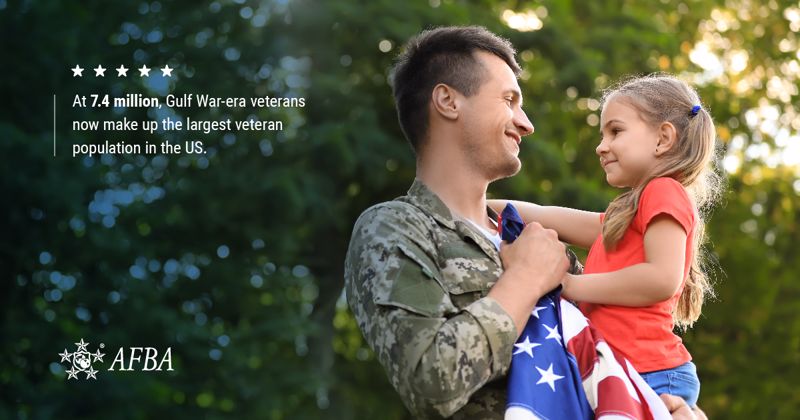 The appearance of the U.S. Department of Defense (DoD) visual information does not imply or constitute DoD endorsement.
The appearance of the U.S. Department of Defense (DoD) visual information does not imply or constitute DoD endorsement.Employment
BLS reports that “Gulf War-era II veterans had the highest unemployment rates from 2009 to 2015.” in 2019, “5.6 million Gulf War-era veterans were employed in 2019, about 6 percent of civilian U.S. workers.” Veterans Affairs (VA) offers programs to help people find opportunities to work, which can assist in matching them with employers who are looking for workers who have their skills.
Related health issues
The Gulf War had relatively few deaths during the conflict, but many of this demographic from this era are facing post-war illnesses. The VA reports that this group often experiences a “cluster of medically unexplained chronic symptoms that can include fatigue, headaches, joint pain, indigestion, insomnia, dizziness, respiratory disorders and memory problems,” called chronic multisymptom illness.
Other serious health issues include:
- Fibromyalgia.
- Myalgic Encephalomyelitis/Chronic Fatigue Syndrome (ME/CFS).
- Functional gastrointestinal disorders.
- PTSD.
Long-term illness may also come from the environment that those who served in the Gulf War found themselves in. This could be things like the effects of sand and dust on the respiratory system and chemical and biological weapon side effects. For those that were in proximity of oil well fires or spent any amount of time in military vehicles that use Chemical Agent Resistant Coating (CARC) paint, health issues may arise.
Gulf War veterans deserve our respect and support for their brave service during their time carrying out the nation’s mission. The demographic of post-war individuals in the country is changing, but their valor hasn’t.
While anyone can experience Post Traumatic Stress Disorder (PTSD) at some point during their lifetimes, it’s highly prevalent among veterans, first responders and active duty service members. Estimates of the rates of PTSD vary by era, but veterans who served during Operations Iraqi Freedom and Enduring Freedom have illness rates of about 11-20%, according to the U.S. Department of Veterans Affairs.
It’s not just combat that causes PTSD among veterans: 23% of women who use VA health care report having been sexually assaulted during their service, further increasing rates of PTSD among veterans.
One type of therapy, in particular, stands out as a unique and effective form of treatment for PTSD: music therapy.
What is PTSD, and why does it matter?
PTSD, once known as shell shock to describe similar symptoms among combat veterans, can be an extremely debilitating condition that can occur after a traumatic event. The disorder is a complicated psychiatric illness. Some symptoms of PTSD include, according to the Anxiety and Depression Association of America (ADAA):
- Intrusive thoughts or dreams about the traumatic experience that happen involuntarily and cause distress. This can include episodes of feeling like the traumatic incident is recurring and acting out the event (sometimes called “flashbacks”).
- Intense psychological distress and usually avoidance of triggers that remind one of the episode.
- An inability to remember details about the incident.
- Increased arousal and reactivity.
- Feelings of detachment or estrangement from other people.
- Persistent fear, horror, anger, guilt, or shame.
Left untreated, these symptoms can worsen over time. That’s why it’s vital for sufferers of PTSD to receive intervention from a qualified professional.
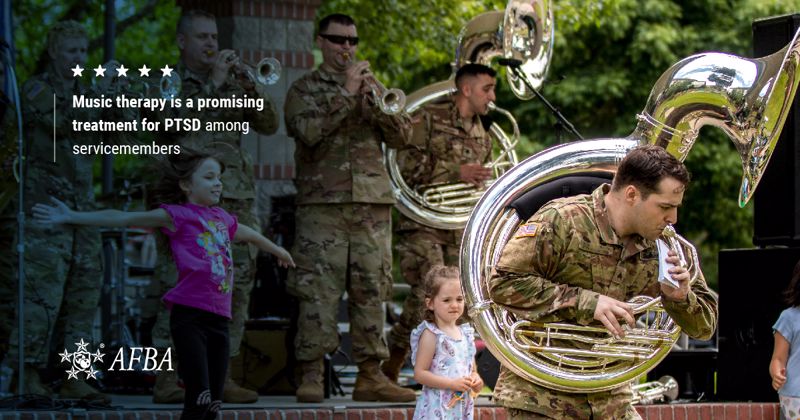 The appearance of the U.S. Department of Defense (DoD) visual information does not imply or constitute DoD endorsement.
The appearance of the U.S. Department of Defense (DoD) visual information does not imply or constitute DoD endorsement.Music therapy and PTSD
One form of complementary treatment to treat PTSD and other psychiatric illnesses, is music therapy. Music therapy is the use of music interventions to accomplish goals, e.g., to treat symptoms of PTSD. It can involve songwriting, or playing or listening to music.
Using music therapy to ease PTSD symptoms goes as far back as 1945 with the military’s Technical Bulletin 187, which observed how music affected the reconditioning of service members in Army hospitals.
The U.S. War Department discovered that music positively affected soldiers’ PTSD rehabilitation programs. This effect was demonstrated during physical reconditioning, occupational therapy, education, and recreation. The military followed up on this after the study was completed, attempting to further explore the possibilities of using music during therapy for recovering soldiers.
Various organizations have developed applications as a result of these studies to include programs ranging from active duty airmen improving their stress management and coping skills with music to using songwriting to treat PTSD symptoms.
Why use music therapy when traditional cognitive behavioral treatment exists?
Music therapy can be less intimidating than cognitive behavioral therapy (CBT) because of one factor: stigma. Despite the ongoing efforts by mental health professionals to encourage those with psychiatric symptoms to seek counseling and psychiatric treatment, there is still a strong aversion toward seeking mental health services. According to a recent study by the World Health Organization, between 30-80% of people with psychiatric illnesses do not seek treatment.
Many see music therapy as less intimidating or stigmatizing than psychotherapy, and thus is more broadly accepted.
Music therapy is a promising treatment for PTSD among service members
Since its initial success during World War II to treat symptoms of PTSD and promote recovery, associations such as the American Music Therapy Association (AMTA) have helped develop its use to treat psychiatric illnesses such as PTSD.
There’s a long way to go until any PTSD treatment is perfected and universally helpful for sufferers of its symptoms, but music therapy is helping lead the way as a promising source of hope.
